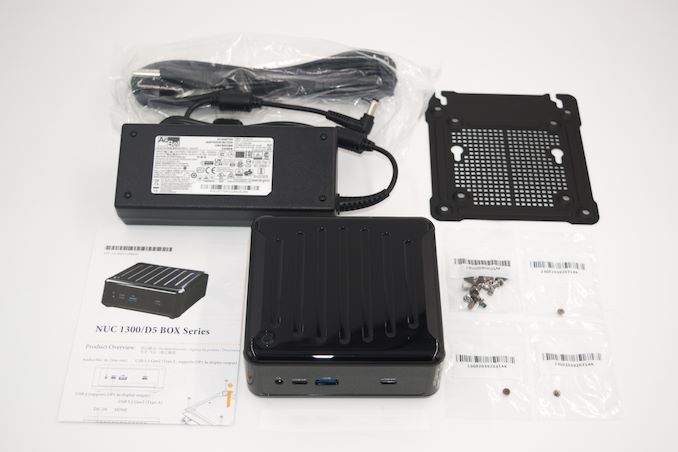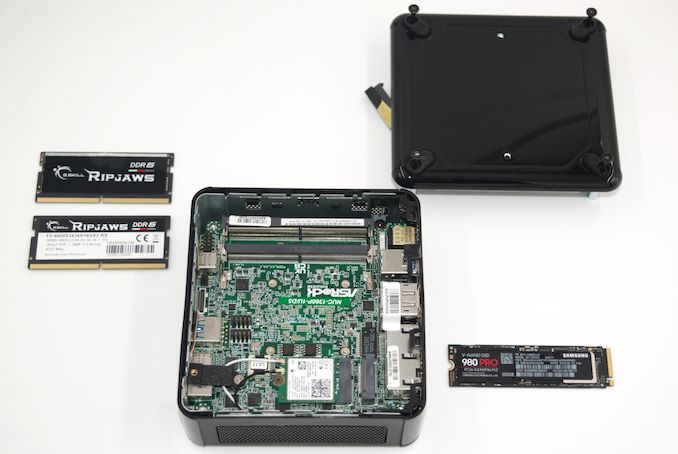ASRock Industrial NUC BOX-1360P/D5 Review: Raptor Lake-P on the Leading Edge
by Ganesh T S on July 18, 2023 10:30 AM EST- Posted in
- Systems
- Intel
- UCFF
- Mini-PC
- ASRock Industrial
- Raptor Lake-P

ASRock Industrial has been a key player in the ultra-compact form-factor (UCFF) PC space over the last few years. They have managed to release 4"x4" systems based on the latest AMD and Intel platforms well ahead of other vendors. The company's NUC(S) BOX-1300 series was launched along with Intel's introduction of Raptor Lake-P in January. The NUCS BOX-1360P/D4 was made available in early February because it broadly carried over the same board components and DDR4 support of the previous generation (NUC BOX-1200 series) product.
The NUC BOX-13xxP/D5 series was introduced in January, but has taken a couple of quarters to appear in retail. The system supports DDR5 SODIMMs and uses a Hayden Bridge retimer on the Thunderbolt 4 port in order to enable USB 3.2 Gen 2x2 support in the front panel's Type-C ports.
Our review of the NUCS BOX-1360P/D4 already brought out the performance benefits of Raptor Lake-P over the previous generation -P series offerings. We also took a second deep dive into Raptor Lake-P in our review of the Arena Canyon NUC. Both systems used DDR4-3200 SODIMMs. Does DDR5 make a difference in Raptor Lake-P performance over DDR4? This review provides a comprehensive look at the NUC BOX-1360P/D5 and attempts to answer that question at different power limits for the processor.
Introduction and Product Impressions
Intel's Raptor Lake-P is an evolved version of Alder Lake-P in a more efficient manufacturing process. It retains the heterogeneous computing architecture with a mixture of performance and efficiency cores. Desktop Raptor Lake is equipped with improved cache sizes for the performance cores and more number of efficiency cores compared to desktop Alder Lake. However, the improvements in the -P series come entirely from the updated V-F curves. The turbo clocks are higher, allowing for better performance and power efficiency within the same nominal TDP of Alder Lake-P. Raptor Lake-P also includes additional Thunderbolt 4 ports and USB 3.2 Gen 2x2 support, subject to the adoption of specific board components.
ASRock is a well-known vendor in the consumer motherboard and mini-PC market. In 2011, the company set up the ASRock Industrial business unit to focus on industrial motherboards. The division branched out in 2018 as an independent vendor with exclusive focus on B2B products. The company has products for deployment in small businesses (offices), automation, robotics, security, and other industrial / IoT applications. As a company with a B2B focus primarily, the focus is on the development and sales of motherboards to various system integrators who can do their own value additions. The company also sells mini-PCs based on the developed motherboards into the retail channel. We have taken a close look at the performance profile of various ASRock Industrial UCFF PCs before, including that of the NUC BOX-1260P based on the Core i7-1260P Alder Lake-P processor and the NUCS BOX-1360P/D4 based on the Core i7-1360P Raptor Lake-P processor.
The company provided us with a barebones sample of the NUC BOX-1360P/D5 a few months back. It is their first Intel-based UCFF PC with DDR5 support. Unlike the NUCS BOX-1360P/D4 slim version without 2.5" drive support, the NUC BOX-1360P/D5 falls back to the I/O and chassis design seen in the NUC BOX-1200 series. Users get a 2.5" SATA drive bay, dual LAN capabilities, and both HDMI and DisplayPort display output options. The key differences compared to the NUCS BOX-1360P/D4 are summarized below.
- Replacement of DDR4-3200 SODIMM slots with DDR5-4800 SODIMM slots
- Additional 2.5 GbE RJ-45 port
- Replacement of a HDMI 2.0a port with a full-sized DisplayPort 1.4a port
- USB 3.2 Gen 2x2 (20 Gbps) support on both Type-C ports
- Hayden Bridge retimer for the Thunderbolt 4 port (compared to Burnside Bridge in the NUCS BOX-1360P/D4)
ASRock Industrial delivers the NUC BOX-1360P/D5 in a non-descript box (with no inkling of the model inside the package). In addition to the main unit, the company includes a VESA mount with screws, M.2 mounting screws, a quick guide for assembling the system, and a 120W (19V @ 6.32A) adapter with a geo-specific power cord within that.
ASRock Industrial markets their mini-PCs in a barebones configuration, with the choice of RAM and SSD left to the end user. Installing these components involves removing four screws from the underside of the unit and slotting in the SODIMMs and affixing the M.2 SSD with a screw. Like the previous members in the NUC BOX series, the screw slot for the M.2 2280 SSD is on a separate plastic tab. The side of the chassis are perforated for air intake and the rear has the air vent that allows the laptop-style blower fan to exhaust air after passing it through the heat spreader. Pictures of the chassis as well as the board are available in the gallery below.
The barebones version of the NUC BOX-1360P/D5 needs DDR5-4800 SODIMMs and a M.2 SSD or 2.5" SATA drive to complete the build. We opted to install 2x 16GB of G.Skill's RipJaws DDR5-4800 SODIMMs along with a 500 GB Samsung SSD 980 PRO M.2 2280 NVMe SSD.
Windows 11 Enterprise 21H2 along with the latest updates was installed prior to proceeding with the performance evaluation. Similar to other UCFF PCs from ASRock Industrial, the NUC BOX-1360P also allows the CPU operation mode to be set to either 'Normal' (default) or 'Performance'. The fan is set to full speed at all times in the latter setting, but has the advantage of a higher PL1 limit (40W vs. 28W) for the processor. The full specifications of the review sample in both modes are provided in the table below.
| Systems Specifications (as tested) |
||
| ASRock NUC BOX-1360P-D5 (Performance) | ASRock NUC BOX-1360P-D5 (Normal) | |
| Processor | Intel Core i7-1360P Raptor Lake 4P + 8E / 16T, up to 5.0 GHz (P) up to 3.7 GHz (E) Intel 7, 18MB L2, Min / Max / Base TDP: 20W / 64W / 28W PL1 = 40W, PL2 = 64W |
Intel Core i7-1360P Raptor Lake 4P + 8E / 16T, up to 5.0 GHz (P) up to 3.7 GHz (E) Intel 7, 18MB L2, Min / Max / Base TDP: 20W / 64W / 28W PL1 = 28W, PL2 = 64W |
| Memory | G.Skill RipJaws F5-4800S3434A16GA2-RS DDR5-4800 SODIMM 34-34-34-76 @ 4800 MHz 2x16 GB |
G.Skill RipJaws F5-4800S3434A16GA2-RS DDR5-4800 SODIMM 34-34-34-76 @ 4800 MHz 2x16 GB |
| Graphics | Intel Iris Xe Graphics (96EU @ 1.50 GHz) |
Intel Iris Xe Graphics (96EU @ 1.50 GHz) |
| Disk Drive(s) | Samsung SSD 980 PRO (500 GB; M.2 2280 PCIe 4.0 x4 NVMe;) (Samsung 128L V-NAND 3D TLC; Samsung Elpis Controller) |
Samsung SSD 980 PRO (500 GB; M.2 2280 PCIe 4.0 x4 NVMe;) (Samsung 128L V-NAND 3D TLC; Samsung Elpis Controller) |
| Networking | 1x 2.5 GbE RJ-45 (Intel I226-LM) 1x 2.5 GbE RJ-45 (Intel I226-V) Intel Wi-Fi 6E AX210 (2x2 802.11ax - 2.4 Gbps) |
1x 2.5 GbE RJ-45 (Intel I226-LM) 1x 2.5 GbE RJ-45 (Intel I226-V) Intel Wi-Fi 6E AX210 (2x2 802.11ax - 2.4 Gbps) |
| Audio | Realtek ALC256 (3.5mm Audio Jack in Front) Digital Audio with Bitstreaming Support over HDMI and Display Port |
Realtek ALC256 (3.5mm Audio Jack in Front) Digital Audio with Bitstreaming Support over HDMI and Display Port |
| Video | 1x HDMI 2.0b (Rear) 1x DisplayPort 1.4a (Rear) 1x DisplayPort 2.1 (Front / USB4) 1x Display Port 1.4a over Type-C Alt-Mode |
1x HDMI 2.0b (Rear) 1x DisplayPort 1.4a (Rear) 1x DisplayPort 2.1 (Front / USB4) 1x Display Port 1.4a over Type-C Alt-Mode |
| Miscellaneous I/O Ports | 1x USB4 / Thunderbolt 4 Type-C (Front, up to 40 Gbps) 1x USB 3.2 Gen 2x2 Type-C (Front, with DP Alt Mode) 1x USB 3.2 Gen 2 Type-A (Front) 2x USB 3.2 Gen 2 Type-A (Rear) |
1x USB4 / Thunderbolt 4 Type-C (Front, up to 40 Gbps) 1x USB 3.2 Gen 2x2 Type-C (Front, with DP Alt Mode) 1x USB 3.2 Gen 2 Type-A (Front) 2x USB 3.2 Gen 2 Type-A (Rear) |
| Operating System | Windows 11 Enterprise (22000.2124) | Windows 11 Enterprise (22000.2124) |
| Pricing | US $670 (barebones) US $810 (as configured, no OS) |
US $670 (barebones) US $810 (as configured, no OS) |
| Full Specifications | ASRock Industrial NUC BOX-1360P/D5 Specifications | ASRock Industrial NUC BOX-1360P/D5 Specifications |
The next section takes a look at the various BIOS options and follows it up with a detailed platform analysis.


















21 Comments
View All Comments
Grapple - Tuesday, July 18, 2023 - link
Would love to see an Intel T-series (35W) processor SFF/UCFF in the comparison mix, such as the Lenovo ThinkStation P3 Tiny or its predecessor, the P360 Tiny.meacupla - Tuesday, July 18, 2023 - link
It seems like it is only worth it, if it cost less than a 7735U or 7740Unandnandnand - Wednesday, July 19, 2023 - link
You mean 7840U. There is no 7740U.meacupla - Wednesday, July 19, 2023 - link
yeah, that one. I hate AMD's naming scheme. It's so confusing.fallaha56 - Wednesday, July 19, 2023 - link
Yes but the Zen4 7840U will destroy the Intel chipOdd not to see one of the many models of equivalent AMD NUC here…
[email protected] - Thursday, July 20, 2023 - link
The Intel version is roughly $200-300 more than a 7735U which is roughly equal in performance.I got tired of all the Intel microcode patches and went AMD. On top of that Intel has the ME which is not really needed for the single user and is another security hole.
Samus - Tuesday, July 18, 2023 - link
It's good to see they took Thunderbolt into consideration here. That's a real oversight to this day on professional and enterprise products that annoys the crap out of me, ie, the Probook 450 G9 and 650 G9 are identical down to the case and internals except for one IC (Burnside) that adds TB4. PCIe 4.0 storage is nerfed in firmware on the 450 (limited to 3.0) but easily reactivated with a hex editor.The 650 model sells at a $300 MSRP markup over the nerfed 450. It's ridiculous.
That said, if this thing has full TB4, it's strange they are using so much real estate for display ports when they could put 2x TB4 Type-C ports in their place offering substantially more capability. Throw in a $5 dongle for DP.
meacupla - Tuesday, July 18, 2023 - link
USB-C to Displayport adapters are usually $15~20Samus - Wednesday, July 19, 2023 - link
$8 on Amazon, $10 for Lenovo branded one, and those are retail price. An OEM buying thousands in bulk will get them for a few bucks a pop. Not to mention the ports are cheaper and simpler to implement on a PCB over the higher pin count (and license requirements) or HDMI. The whole thing stinks like yesterdays diapers.fallaha56 - Wednesday, July 19, 2023 - link
Come on guysAny Zen4 7840U NUC will destroy the ‘cutting edge’ Intel chip here
Let’s see one of the many models of equivalent AMD NUC reviewed…